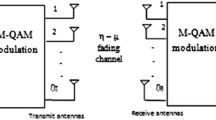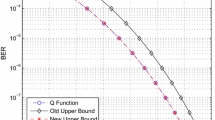Abstract
Interleaving is an efficient measure to resolve the bursty errors in a block fading multiple-inputs multiple-outputs (MIMO) system. For the metrics of network layer, interleaving exerts two conflicting effects on the ultimate delay performance. Specifically, interleaving can advantageously reduce data transmit time. On the other hand, it comes at a cost, entailing an undesired delay penalty resulting from interleaving depth. Here, we exploit a unified model to accommodate these two conflicting effects, and derive the average waiting time in block fading MIMO systems with dynamic-depth interleaving. Such a unified model is developed with a combined method of both information theory and queueing theory. Therefore, the model is capable of characterizing the randomness of data arrival process, hence the nature of dynamic-depth interleaving. The methodology and the results are applicable to designing, evaluating, and tuning the practical interleaving systems.
Similar content being viewed by others
Explore related subjects
Discover the latest articles and news from researchers in related subjects, suggested using machine learning.References
Biglieri E, Proakias J, Shamai (Shitz) S. Fading channels: Information-theoretic and communications aspects. IEEE Trans Inf Theory, 1998, 44: 2619–2692
Bertsekas D, Gallager R. Data Networks. Englewood Cliffs, NJ: Prentice-Hall, 1987. 111–112
Jootar J, Zeidler J, Proakias J. Performance of convolutional codes with finite-depth interleaving and noisy channel estimates. IEEE Trans Commun, 2006, 54: 1775–1786
Rice M, Perrins E. A simple figure of merit for evaluating interleaver depth for the land-mobile satellite channel. IEEE Trans Commun, 2001, 49: 1343–1353
Kaplan G, Shamai (Shitz) S. Error probability for the block-fading Gaussian channel. Arch Electronik Bertragungstech, 1995, 49: 192–205
Medhi J. Stochastic Models in Queueing Theory. 2nd ed. San Diego, California: Academic Press, 2003
Foschini G J, Gans M J. On the limits of wireless communications in a fading enviorment when using multiple antennas. Wirel Person Commun, 1998, 6: 311–335
Wang Z, Giannnakis G B. Outage mutual information of space-time MIMO channel. IEEE Trans Inf Theory, 2004, 50: 657–662
Bettesh I, Shamai (Shitz) S. Optimal power and rate control for minimal average delay: The single-user case. IEEE Trans Inf Theory, 2006, 52: 4115–4141
Janssen A J E M, Van Leeuwaarden J S H. Analytic computation schemes for the discrete-time bulk service queue. Queu Syst, 2005, 50: 141–163
Bailey N T J. On queueing process with bulk service. J Royal Statist Society, Ser B, 1954, 16: 80–87
Author information
Authors and Affiliations
Corresponding author
Rights and permissions
About this article
Cite this article
Guo, H., Hu, H. & Zhang, Y. Waiting time in block fading MIMO systems with dynamic-depth interleaving. Sci. China Inf. Sci. 53, 1622–1627 (2010). https://doi.org/10.1007/s11432-010-4018-5
Received:
Accepted:
Published:
Issue Date:
DOI: https://doi.org/10.1007/s11432-010-4018-5




